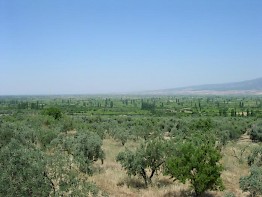Corupedium (281 BCE)
Q47299Corupedium: site of the decisive battle in the war between Seleucus Nicator and Lysimachus (281 BCE).

After the death of Alexander the Great (11 June 323 BCE) in Babylon, his successors had fought several wars. The result of one of these, the Babylonian War, was that a superpower was created in Asia, the Seleucid Empire, named after its founder, Seleucus Nicator. In 301, he and his ally Lysimachus of Thrace defeated their common enemy Antigonus Monophthalmus at Ipsus. His possessions were divided: Seleucus received Syria and eastern Anatolia, Lysimachus took Anatolia west of the river Halys.
There was a big difference between the two empires. Seleucus' kingdom was essentially a continuation of the Achaemenid Empire, and the people felt they belonged together. Lysimachus, on the other hand, ruled over territories that had a strong sense of independence. Seleucus just had to wait until an incident would destabilize the kingdom of his former ally - and then he could strike and reunite the former Achaemenid possessions.
This incident happened in the first weeks of 282 BCE. Many years before, Lysimachus had married Nicaea. They had a son, Agathocles, Lysimachus' trusted right-hand man and the one who was appointed as successor. In 299, both men had married to daughters of Ptolemy I Soter of Egypt: Lysimachus had taken Arsinoe as his wife, and Agathocles had married Lysandra. Now Arsinoe, seeing that she and her children would become subjects of her stepson and her sister, decided to blacken Agathocles' reputation, so that her own son would become king.

At least, this is what our sources say. It should however be noted that Ptolemy had died in January 282. It is possible that political motives also played a role in the unfolding drama, and it is possible that Agathocles was not entirely blameless. But whatever the reasons, Agathocles was killed by his father.
Immediately, Agathocles' wife Lysandra fled to Seleucus and asked him to come to her assistance. This was an offer Seleucus could not refuse: he could rightfully intervene in Thrace -where he could place the son of Lysandra and Agathocles on the throne. The thought that he could also place himself on Lysimachus' throne may have crossed his mind.
In the winter of 282/281, he invaded Lysimachus' Asian possessions - essentially reclaiming for his kingdom what had once been Achaemenid. The army of the seventy-seven years old Seleucus met the army of Lysimachus, eighty years old, at Corupedium, in the west of Asia Minor, in February 281. There is no account of the course of the battle, but it is extremely likely that Seleucus put his elephants to good use. However that may be, the results were clear: by the end of the day, Lysimachus was dead. This was the last time that two former officers of the army of Alexander clashed.

Seleucus proceeded to the west, where nothing could prevent him from adding Thrace and Macedonia to his empire. However, he was assassinated by Ptolemy Keraunos, a son of Ptolemy who had been expelled. We do not know his motives. Thus ended the life of Seleucus. In a few year's time, the four main players of the game of hellenistic state building had all died: Demetrius in 283, Ptolemy in 282, Lysimachus and Seleucus in 281. The age of Alexander's Successors was over.
Sources
There is no description of the battle itself, but the general context is offered by Appian, Syrian Wars, 62. The name of the battlefield is mentioned by Porphyry (FGrH 260 F 3, 8). New evidence for the preparations of the battle has recently been discovered in one of the Babylonian Chronicles, called the End of Seleucus chronicle.